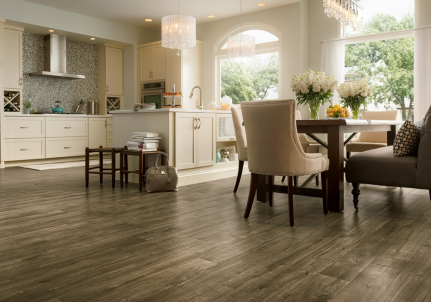

1. Prioritize Health
When choosing a vinyl floor for your home, it's essential to consider the long-term health implications for both you and your children. In the past, research has shown that low-end vinyl floors emit higher levels of formaldehyde compared to higher-end options. Formaldehyde can have detrimental effects on long-term health, especially for young children with weaker immune systems. For a healthier choice in the long run, opt for vinyl floors that meet the E1 standard and have minimal formaldehyde emissions.
2. Ensure Safety
High-quality vinyl flooring often incorporates grooves and textures for two purposes: mimicking the look of real wood and enhancing slip resistance. In addition to preventing slips, top-notch vinyl floors usually possess fire resistance certification. These floors undergo rigorous testing, including exposure to fire, to ensure they do not contribute to the spread of flames in the event of an accident.
3. Consider Price
It is important to note that the cheapest vinyl flooring may not be of good quality, and the most expensive doesn't necessarily guarantee superiority. Nowadays, consumers tend to consider the long-term maintenance costs of the floors they choose. Price should be viewed in the context of the future. When selecting a vinyl floor, look for features such as 100% waterproofing, particularly if you live in a humid environment like Singapore or Southeast Asia. Additionally, consider the floor's resistance to heavy impact and abrasion. Low-end vinyl floors often wear out easily, which can become a significant expense if you need to replace them in commercial areas with high foot traffic, like retail shops.
4. Prioritize Comfort
While you cannot see what lies beneath the surface of a vinyl floorboard, you can certainly feel it. Lower-end vinyl floors tend to have lower density, resulting in a hollow sound when walked upon, creating a noisy floor. Additionally, check if the floor offers thermal stability. Floors with unstable thermal properties retain unnecessary heat, causing discomfort when touched. Reputable vinyl flooring brands, such as EVORICH, continually strive to improve walking comfort for their customers by developing higher quality vinyl flooring options.
5. Think Environmentally
As our lives become increasingly busy, we may unintentionally overlook our impact on the environment. With the growing demand for vinyl floors, some profit-driven businesses worldwide have begun mass-producing vinyl floorboards that fail to meet global environmental standards. While protecting the environment may seem like a daunting task, our future generations will benefit from our actions if each individual plays their part in being eco-friendly. Choose a vinyl floor brand that adheres to environmental ISO standards or holds certifications like the Singapore Green Label, such as Evo HERF, to contribute to the eco-era and fulfill your role in preserving the environment.
When choosing the best vinyl flooring for your needs, consider the following four main types:
1. Luxury Vinyl Tiles (LVT): LVT is a highly popular option known for its durability. It consists of multiple layers, including an underlay, rigid core, high-quality image layer, strong wear layer, and UV layer for color protection. LVT offers a wide range of finishes, such as wood, stone, and tile effects.
2. Click Vinyl: Unlike traditional vinyl tiles or planks that are glued down, click vinyl pieces fit tightly together, creating a nearly seamless vinyl sheet. In smaller rooms, click vinyl can be "floated" without adhesive, making installation easier and quicker.
3. Self-Adhesive Vinyl: Although less common, self-adhesive vinyl is incredibly convenient to install. These tiles come with an adhesive layer pre-applied, eliminating the need for glue. Simply remove the backing sheet, firmly press the tiles down, and your floor is ready without any sticky mess or drying time.
4. Roll Vinyl: As the name suggests, roll vinyl comes in wide rolls and is either floated or glued down to the subfloor. It is particularly suitable for areas prone to moisture, like bathrooms, as there are fewer seams for moisture to penetrate.
Here are some key points to keep in mind:
When evaluating different types of vinyl flooring, it's important to consider various characteristics and installation needs. Here are some key points to keep in mind:
1. Product Thickness: Regardless of the type of vinyl flooring, compare the overall thickness of each product. Thicker vinyl sheets, tiles, or planks generally offer better comfort underfoot and increased durability.
2. Wear Layer: Check the thickness of the wear layer, which should be the topmost layer of the vinyl flooring. A wear layer with a thickness of at least 5mm is preferable, as it contributes to the durability and longevity of the product.
3. Printed vs. Inlaid Design: The surface design of vinyl flooring can be achieved through different methods. Cheaper options may feature a printed design layer, while higher-quality and more durable products often have an inlaid design that extends throughout the vinyl's thickness. Inlaid designs provide enhanced durability.
4. Surface Texture: If slipperiness is a concern, look for vinyl flooring with a textured surface that offers better traction. Luxury vinyl or vinyl composite tiles generally provide more grip, while sheet vinyl can be more slippery when wet.
5. Backing: Different types of vinyl flooring may have various backings that require specific installation methods. Some backings are self-adhesive, while others are not. Backings can be cushioned or hard, and the type and quality of the backing will impact the performance and price of the product. Cushioned backings, such as synthetic or cork, offer benefits like noise reduction, added warmth, and improved insulation.
Considering these factors will help you make an informed decision when selecting the best vinyl flooring option for your specific needs and preferences.
For more information, welcome contact us or click to the website: https://www.trioflor.net/